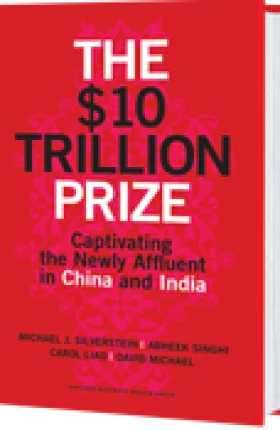Shriram is a handsome young man—tall and slender, with short black hair and a carefully trimmed goatee—who “thinks in English” and could easily pass for an American teenager. We call him Mr. Number 19 because he ranked 19 out of more than 400,000 Indians taking the entrance exam to the prestigious Indian Institutes of Technology (IIT).
Related Content: The $10 Trillion Prize
A series of Perspectives looks at what the growth of consumer spending in China and India means for business and society.
It took Shriram two years of constant studying—at 80 to 90 hours a week—to earn his place at IIT. “All my life I wanted to be here,” he told us as he sat on IIT’s Delhi campus. “I knew that if I could go to IIT, major in engineering, and study hard, my life would be perfect. I would marry a beautiful girl, start a company, help my country advance, and deliver on my family’s hopes and dreams. IIT is the pinnacle.”
Liu Yiting is a beautiful woman who dresses like the affluent Manhattan professional that she is—black leather pumps, a black cashmere cardigan, a black and white print sheath dress, pearl jewelry, and an oversized leather handbag slung over one shoulder. She is also known as Harvard Girl, after the book written by her parents that told of her extraordinary rise from difficult circumstances in southwest China to a coveted place at the most famous university in the United States.
Like Mr. Number 19, she had to work hard to become what she is today: a poster child for the next generation of women of Chinese descent. “I still say it is the hardest I’ve ever worked in my life,” she notes, recalling her efforts to enter a U.S. university. “I remember one day sitting over those application essays late at night, and I just started to cry because I was so exhausted.”
Mr. Number 19 and Harvard Girl are superachievers—but they typify the investment in time and money that young people in China and India are making in their education. The Chinese say that “compared with education and learning, everything else is secondary.” People are prepared to make big sacrifices for a good education. So, too, are governments.
The BCG E4 Index
China and India have made education reform a core building block of their five-year plans. They realize that they need to transform their populations from day laborers into knowledge workers and create a skilled workforce for the economy of the future. They understand that there is a straightforward equation: education equals higher-paying work, greater productivity, and more innovation.
Over the course of this decade, there will be a rushing stream of college graduates from the two countries’ educational systems―some 83 million graduates in China and 54 million in India between 2011 and 2020, compared with only 30 million in the United States and even fewer in Europe. Better educated than their parents, these young people will command higher incomes, and with this extra money they will become key contributors to what we project will be a combined $10 trillion in annual consumer spending in China and India by the year 2020―which we refer to as the “$10 trillion prize.”
The next generation of Chinese and Indian consumers is in the classroom now. China currently has 235 million students and India has 244 million. Both countries are investing heavily in education, with China allocating 15 percent of government spending to education and India allocating 11 percent.
But if these are impressive statistics, it remains the case that China and India have far to go before they can match the U.S. educational system. According to the Times Higher Education World University Rankings, the United States takes the top five spots, with Harvard in first place. The United States has 7 of the top 10 universities, 27 of the top 50, and 72 of the top 200.
Of course, the United States is also a so-called bimodal country, with one group of its citizens reaching a high level of educational and career achievement and the other group ending up largely left behind. According to the U.S. Department of Education, about 30 percent of young people in the United States do not earn a high school diploma. The lack of a diploma translates into a lifetime of lower wages and higher unemployment. College graduates earn twice as much as those with high school diplomas—and a newly qualified engineer in the United States outearns the average worker by at least 50 percent, enjoying lifetime earnings of $4.2 million, on average.
In order to deepen such comparisons, we developed the BCG E4 Index, which provides a four-pronged measure of the relative global competitiveness of a country’s overall educational system on the basis of the following metrics:
- Enrollment: the number of students in the educational system
- Expenditure: the level of investment in education by both governments and private households
- Engineers: the number of qualified engineers entering the workforce
- Elite Institutions: the number of top global institutions of higher education
We weighted the four components equally on a 1,000-point scale.
Using this approach to compare the educational systems of ten leading countries, we found that the United States and the United Kingdom are ranked first and second, respectively, driven by their dominance in raw spending, engineering graduate rates, and globally ranked universities. (See the exhibit “BCG’s E4 Index of Education Strength.”) China ranks third—largely because of its high enrollment—ahead of Germany, which ranks fourth on the basis of its strength in spending, engineering graduates, and top universities. India is fifth, again driven almost entirely by enrollment.
The numbers make it clear why the United States and the United Kingdom are global leaders in education―but China and India, if they address the four key areas, could create powerful engines of economic growth and, in so doing, change the balance of power around the world.
Enrollment
Since 1950, China has educated nearly half a billion people, including 400 million through high school and another 60 million through college. It currently claims more than 25 million students attending more than 2,200 colleges and universities—the world’s largest higher-education system. By comparison, India’s educational system is more vulnerable. The IITs are a rarity. About 8 million primary-school-age children from “marginalized” social groups remain out of school, giving India the largest illiterate population of any country in the world—an estimated 300 million, with literacy rates for women averaging 20 points lower than for men.
Expenditure
China spends $300 billion on public education every year (adjusted for purchasing power parity). Next to defense, it is the country’s biggest category of government investment. Families contribute an additional $180 billion in private expenditure. India’s government spends much less: $110 billion. Families contribute $70 billion. In the United States, with one-fourth as many students, spending totals $980 billion, more than twice as much as China and five times as much as India. Harvard University alone has an annual operating budget of approximately $3.9 billion and an endowment of more than $30 billion; some 60 percent of Harvard undergraduates receive financial aid. By way of comparison, the annual operating budget for IIT Delhi—where Mr. Number 19 is a student—is only about $26 million. But it is not just money that counts.
Engineers
The United States is the most engineer-intensive country in the BCG E4 Index, with 981 engineering degrees per million citizens, compared with 553 in China and 197 in India. By this measure, China and India rank very near the bottom, which also reflects the fact that many global companies are skeptical of the standard of the graduates coming out of China’s and India’s universities. The World Economic Forum estimates that 81 percent of U.S. engineering graduates are immediately “employable”—compared with 25 percent of Indian graduates and only 10 percent of Chinese graduates.
Elite Institutions
When it comes to higher education, China and India lag behind: only a relatively small group of students can win access to the top universities in the two countries. The lucky few—such as Mr. Number 19—are handsomely rewarded. We calculate that they will earn a return of at least 30 times their education investment. But the lack of great institutions means that many talented people—such as Harvard Girl—are obliged to travel abroad in search of a world-class education. In fact, there are more than 350,000 Chinese and Indian students currently enrolled in U.S. and U.K. universities. It means, too, that the Chinese and Indian economies lose some of their brightest stars forever. Between 1972 and 2009, some 1.4 million Chinese students emigrated. Of these, only about 400,000—the haiwai guilai (“returned from overseas”)—have gone home, often lured by lucrative packages, large relocation bonuses, and sponsored jobs.
An Opportunity for Revitalization: Next Steps for China and India (and the West)
China and India stand to reap enormous rewards from further investment in education. China needs to create more top-ranked universities with elite graduate programs and excellent faculty. The initiative to establish the C9 League—a Chinese Ivy League—is a big step forward. Meanwhile, India needs to invest in primary education to break the cycle of poverty and illiteracy among its poorest citizens. It should also create incentives, such as high-paying jobs and access to venture funding, to keep its best and brightest in India.
There is much to do. But Westerners should not underestimate the motivation of the hundreds of millions of young people in China and India who are intent on educating themselves and improving their lives. Both Mr. Number 19 and Harvard Girl worked more than ten hours a day for years preparing for their entry to university. As one Shanghai student told us, “Perfection is the goal.” They are hungry for more and share a single-minded determination to succeed and to live a better life. We believe that they represent an entire generation of tremendously driven, talented, and competitive students who will transform the global economy over the next ten years. The global race to educate and train the next generations will drive prosperity, income growth, wealth accumulation, and access to a skilled labor force. The challenge to the West is imminent.
For young people in China and India, education is an opportunity to escape poverty and launch themselves into positions of leadership and success. The fortunate ones who graduate from the elite institutions will literally have longer lives, in addition to earning higher incomes, traveling the world, and influencing the future of their countries in profound ways. They will secure the best jobs, command the highest salaries, move into modern apartments, buy cars and luxury goods, eat higher-quality food, and enjoy access to the best health care and investment services: they will become a distinct consumer market.
The challenge to the West comes from India’s and China’s incremental investment in education. These two countries can change the balance of power with large pools of qualified students trained to global standards. China, in particular, is determined to invest in education. Its latest five-year plan calls for graduates in energy conservation, information technology, biology, advanced manufacturing, and materials science. The United States and other Western countries need to promote math and science education, raise graduation rates, and spur the growth of entry-level jobs.
Over the next decade, global competition for the best-paying jobs will result in stark divisions between the rich and the poor, the educated “haves” and the uneducated “have-nots.” The race to educate the next generation is on. Around the world, it will drive individual prosperity, corporate growth, and national wealth.










